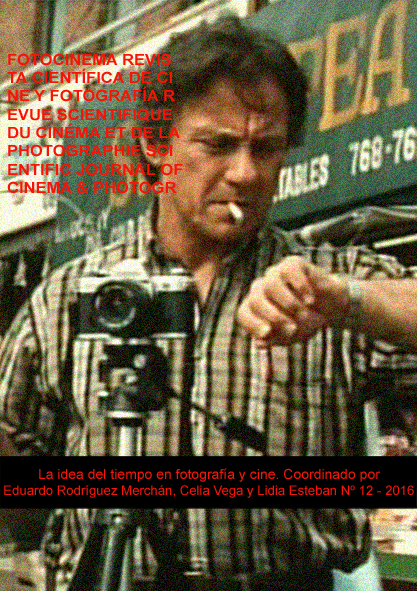Fotografía de larga exposición y cine estructural: una reflexión en torno al Loop
DOI:
https://doi.org/10.24310/Fotocinema.2016.v0i12.6037Abstract
La posibilidad de reflejar el tiempo en la escena fotográfica tiene unos condicionantes estéticos derivados de una necesidad técnica, la apertura y clausura del obturador. Esta guillotina temporal es la encargada de seleccionar el fragmento de tiempo que queremos registrar, de tal manera que las acciones ocurridas durante este periodo obtendrán una representación gráfica. Este articulo trata de reflexionar sobre estas representaciones y a su vez de enlazarlas con la figura del sample y del loop. Se trataría de vincular la posibilidad de representación del tiempo ligado al movimiento a traves de la fotografía, con la idea de repetición temporal que aporta el loop. Elemento que fue desarrollado especialmente por el cine estructural durante la década de los 60. Para ello se estudiarán diversos ejemplos, tanto fotográficos como cinematográficos, de obras que abordan la cuestión de la representación temporal y se relacionarán con documentos escritos sobre el tema.
Abstract:
The possibility to reflect time in the photographic medium has certain aesthetic constrains derived from a technical necessity; the opening and closing of the shutter. This temporary guillotine is responsible for selecting the fragment of time that we want to capture, in a way that the actions that occurred during this period will obtain a graphical representation. This article intends to reflect on these representations and link them with the figure of the sample and the loop. It attempts to link the possibility of representing time, associated to movement through photography, with the idea of temporal repetition of the loop, element which was specially developed by the Structural Cinema movement during the 60's. To find an answer, photographic and cinematographic examples that analyzed the issue of temporary representation will be studied and will be related with written documents about the subject.
Palabras clave:
Fotografía; larga exposición; cine estructural; loop; sample; tiempo.
Keywords:
Photography; Long-exposure; Structural Film; Loop; Sample; TimeDownloads
Metrics
Downloads
Additional Files
Published
How to Cite
Issue
Section
License
All contents published in Fotocinema Revista científica de cine y fotografía are protected under the Creative Commons Attribution-NonCommercial-ShareAlike 4.0 International (CC BY-NC-SA 4.0) license. All about this license is available in the following link: <http://creativecommons.org/licenses/by-nc-sa/4.0>
Users can copy, use, redistribute, share and exhibit publicly as long as:
- The original source and authorship of the material are cited (Journal, Publisher and URL of the work).
- It is not used for comercial purposes.
- The existence of the license and its especifications are mentioned.
There are two sets of authors’ rights: moral and property rights. Moral rights are perpetual prerogatives, unrenounceable, not-transferable, unalienable, imprescriptible and inembargable. According to authors’ rights legislation, Fotocinema. Revista científica de cine y fotografía recognizes and respects authors moral rights, as well as the ownership of property rights, which will be transferred to University of Malaga in open access. The property rights are referred to the benefits that are gained by the use or the dissemination of works. Fotocinema. Revista científica de cine y fotografía is published in an open access form and it is exclusively licenced by any means for doing or authorising distribution, dissemination, reproduction, , adaptation, translation or arrangement of works.
Authors are responsable for obtaining the necessary permission to use copyrighted images.













13.png)




